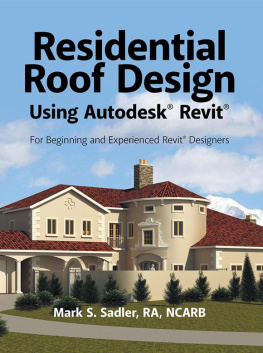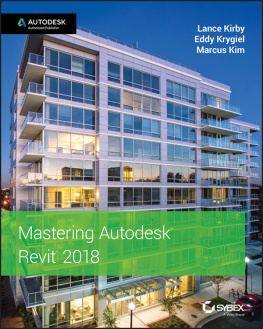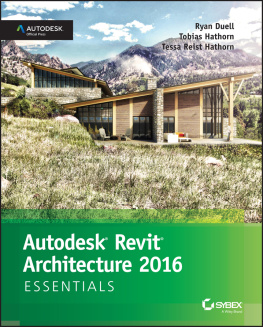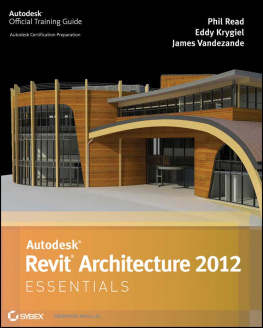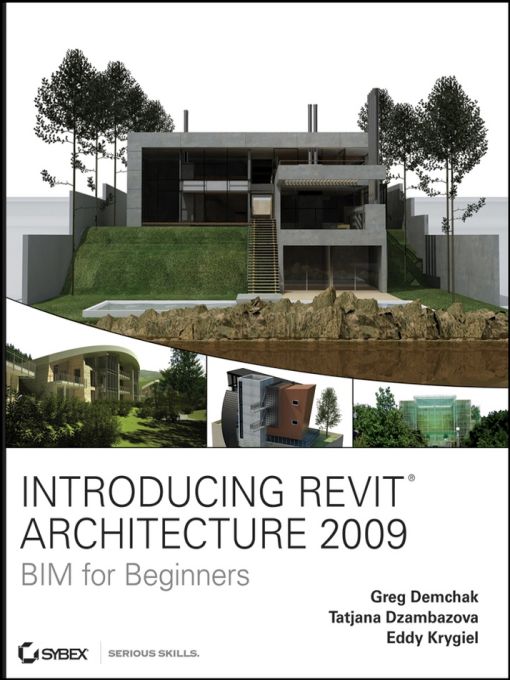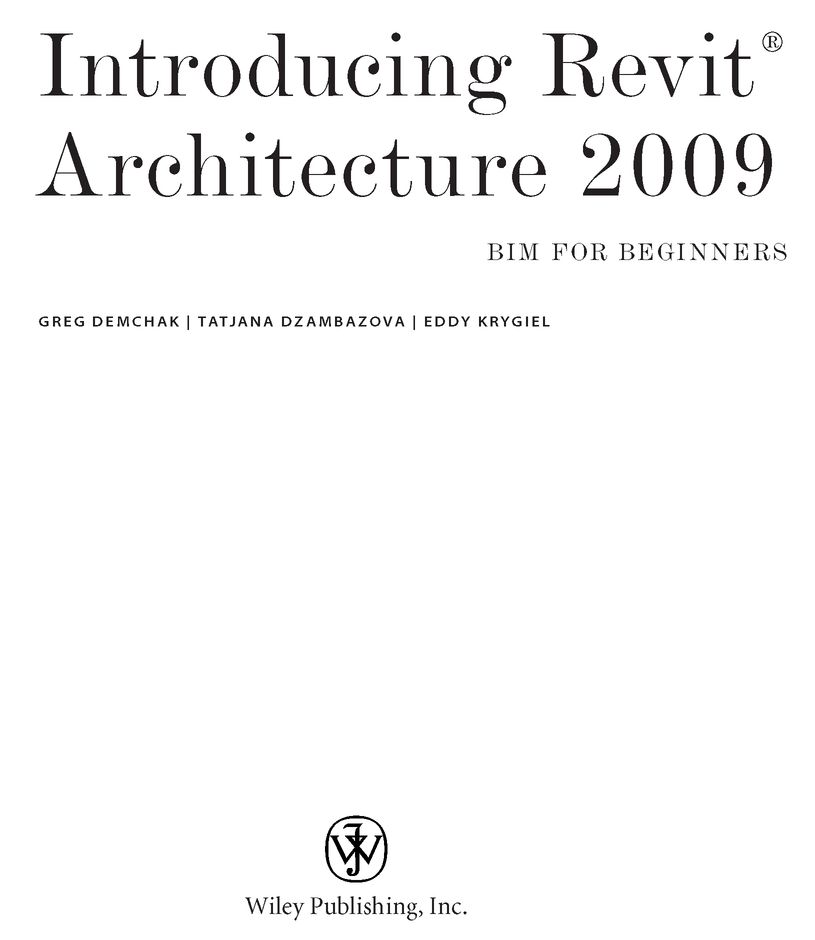Table of Contents
Table of Figures
Dear Reader,
Thank you for choosing Introducing Revit Architecture 2009: BIM for Beginners. This book is part of a family of premium quality Sybex books, all written by outstanding authors who combine practical experience with a gift for teaching.
Sybex was founded in 1976. More than thirty years later, were still committed to producing consistently exceptional books. With each of our titles were working hard to set a new standard for the industry. From the authors we work with to the paper we print on, our goal is to bring you the best books available.
I hope you see all that reflected in these pages. Id be very interested to hear your comments and get your feedback on how were doing. Feel free to let me know what you think about this or any other Sybex book by sending me an e-mail at nedde@wiley.com, or if you think youve found a technical error in this book, please visit http://sybex.custhelp.com. Customer feedback is critical to our efforts at Sybex.
Best regards,
Neil Edde
Vice President and Publisher
Sybex, an Imprint of Wiley
Dedication
For Gage
Greg
For Thea and Michael, who brought love and laughter in my life
Tanja
For my beautiful daughters, Zo and Maya
Eddy
Acknowledgments
Hats off to the innovators who conceptualized, designed, and made Revit happen. You have changed the world! Huge thanks to all the faithful followers! Without you, Revit wouldnt be what it is today. Personal thanks to the grand masters Philippe Drouant and Phil Read for their heroic dedication and help; to Simone Cappochin and Kubik+Nemeth+Vlkovic, who keep on doing beautiful architecture with Revit and are willing to share it with us; and to our friends, Martin Taurer, Paul Woddy, and Emmanuel Di Giacommo, for their contributions A final thank-you to BNIM Architects, who continue to let us use their Revit models to help raise the knowledge base of the design community. To Tsvetan Tsvetanov, whose dedication and hard work was essential to providing Revit with its great new rendering capabilities. Sincere thanks to all the hardworking developers, product designers, and quality assurance testers from the development team of Revit, for their dedication, passion, and love of Revit. And finally, thanks are due to our excellent support team at Sybex, who helped us develop and focus the content; Dick Margulis, for making a philosopher, nonnative English speaker, and a dyslexic look good in print; Liz Welch for making it grammatically correct; Dassi Zeidel for keeping tabs on all the parts and pieces; Eric Charbonneau for keeping things on track; and a special thanks to Willem Knibbe, for his willingness to go to bat for us and deal with our high-maintenance attitudes.
About the Authors
Greg Demchak is a designer, a technology advocate, urban explorer, and post-apocalyptic film producer. He holds architectural degrees from the University of Oregon and Massachusetts Institute of Technology. He is a product designer for Autodesk and has been working with Revit since 2000. He has been teaching at the Boston Architectural College since 2003 and is currently the principal investigator for the 2009 Solar Decathlon competition. He resides in Massachusetts.

Tatjana Dzambazova was the product manager for Revit Architecture between 2005 and 2007, after which she moved into global sales development management for the AEC industry. Before joining Autodesk in 2000, she practiced architecture for 12 years in Vienna and London. At Autodesk, she has focused on evangelizing technology and established herself as an internationally renowned speaker who has fostered relationships with architects and industry leaders from all around the globe. Powered with seemingly unlimited sources of energy and passion, Tanja manages to make three days out of one, always on the hunt of whats new and exciting in the world of architecture and technology; and when she is not working or coauthoring technology books, she is advocating wildlife conservation, reading books like a maniac, getting inspired in the theaters, and playing Scrabble and Texas Hold Em.

Eddy Krygiel is a registered architect, a LEED Accredited Professional, and an Autodesk Authorized Author at BNIM Architects headquartered in Kansas City, Missouri. He has been using Revit since version 5.1 to complete projects ranging from single-family residences and historic remodels to 1.12-million-square-foot office buildings. Eddy is responsible for implementing BIM at his firm and also consults for other architecture and contracting firms around the country looking to implement BIM. For the last four years, he has been teaching Revit to practicing architects and architectural students in the Kansas City area and has lectured around the nation on the use of BIM in the construction industry. Eddy also coauthored Green BIM: Successful Sustainable Design with Building Information Modeling, a book on sustainability and BIM, with Bradley Nies (Sybex, 2008).
Introduction
Welcome to the Second edition of Introducing Revit Architecture, which was written based on the 2009 release of the software.
It was great fun re-visiting our first bookwe worked hard to polish it up, and capture the new features in the 2009 release of Revit Architecture. We enjoyed the synergy of three friends, three architects, three authors collaborating to bring this project into reality. But mostly, we were all driven by the feeling that were doing something great: introducing Revit to those who have not been acquainted with its incredible power and its ability to put some fun back into using software and designing architecture.
This book is written for beginners who have never seen or may have just heard about Revit. Its for architects of any generationyou dont need to be a high-tech wizard to get into Revit. Toward that end, we wanted to make a book that is as much about architecture as it is about software. Weve added many timesaving and inspiring concepts to the book to get you motivated and to help you on your journey into the new era of building information modeling (BIM). We think weve succeeded, because the book is full of real-world examples that show how to use Revit practically and creatively based on all of our experiences out there in professional practice.
This book will help you learn Revit and BIM basics easily and efficiently via straightforward explanations, real-world examples, and practical tutorials that focus squarely on accomplishing vital Revit tasks.


